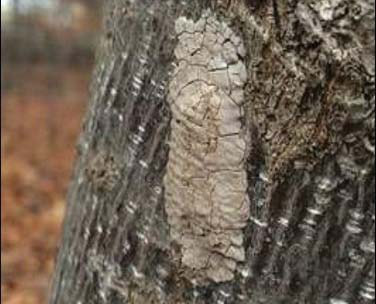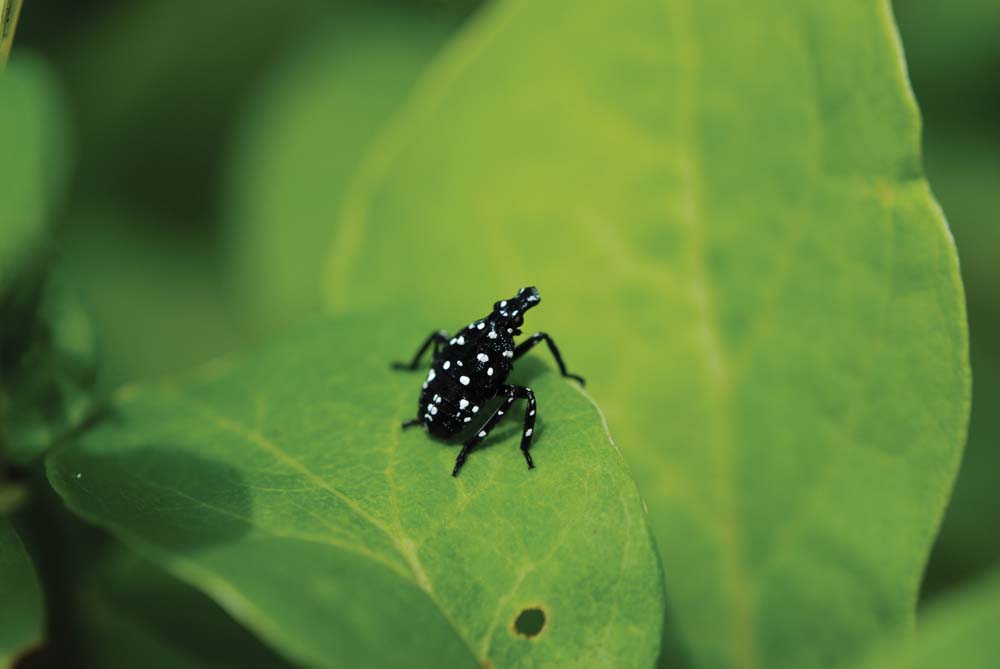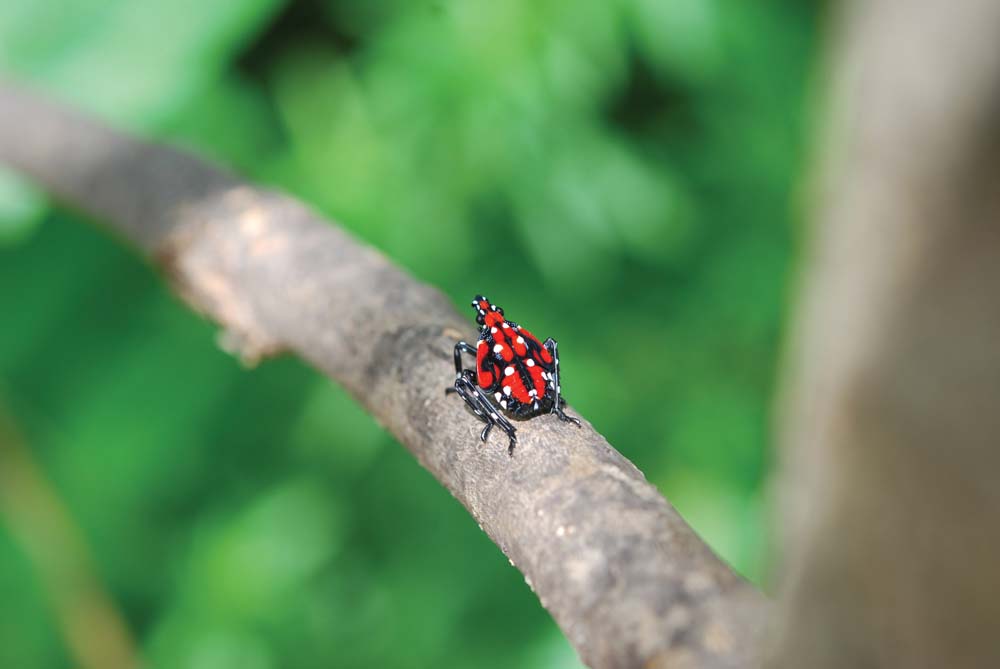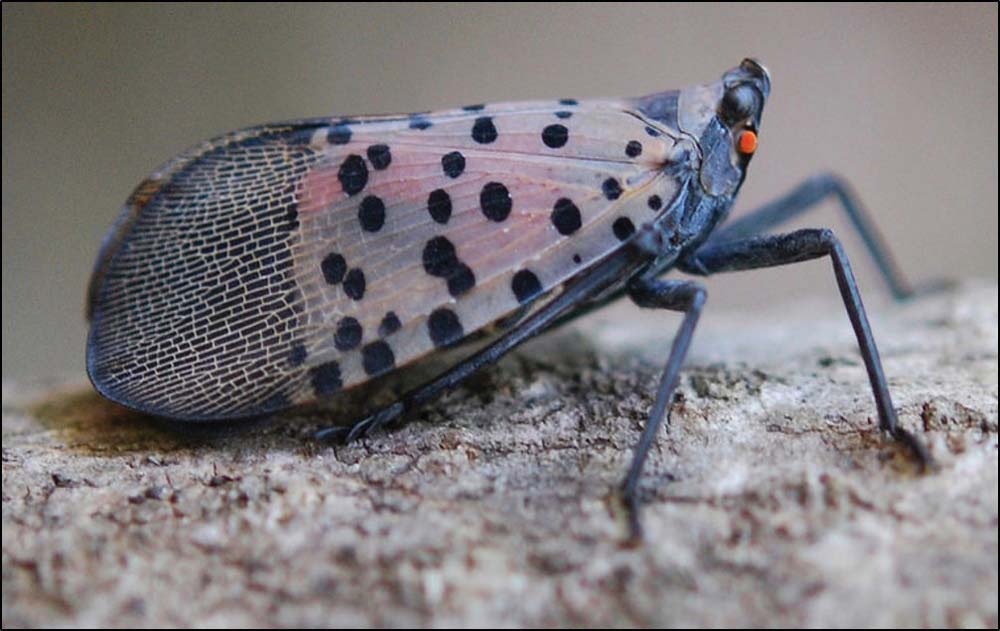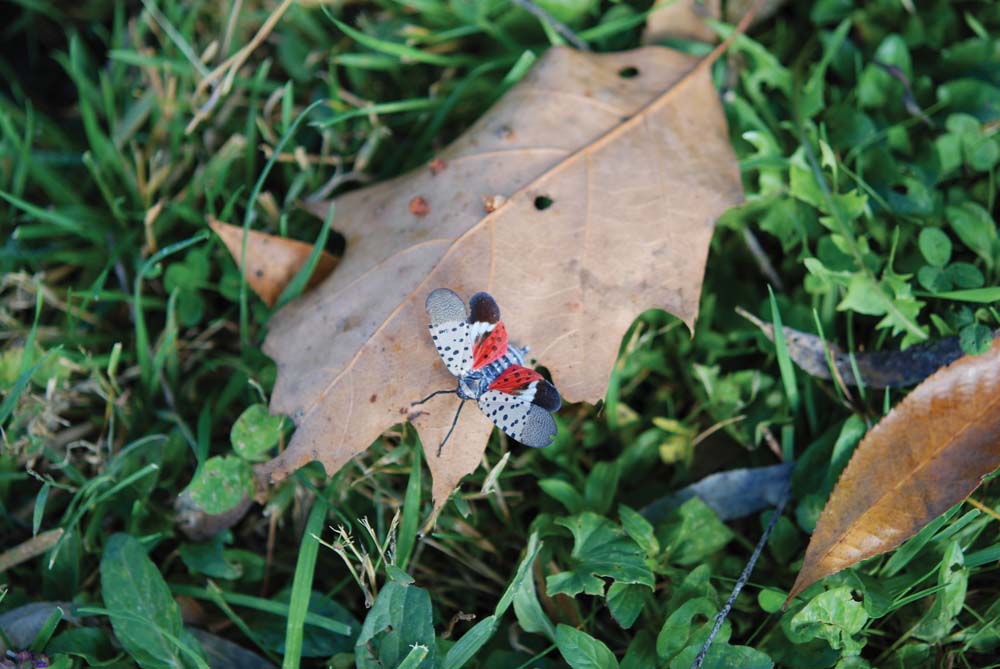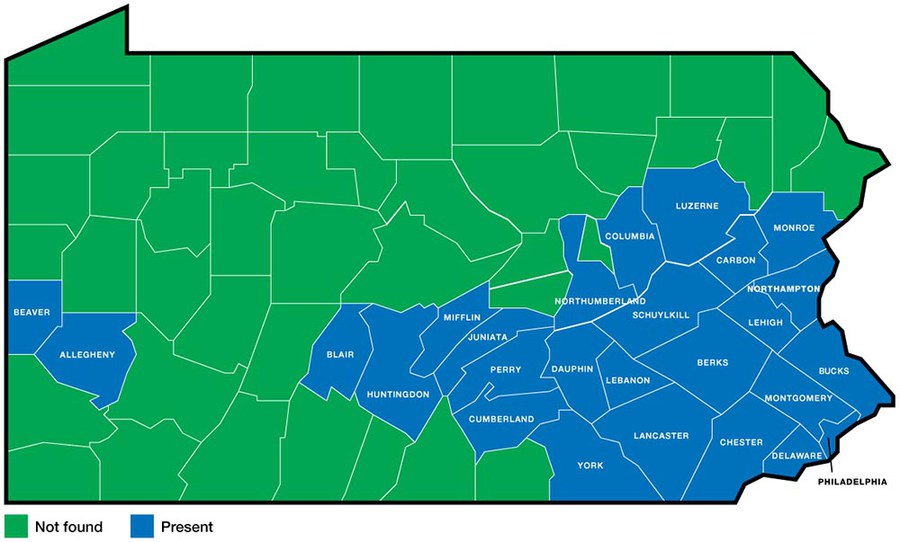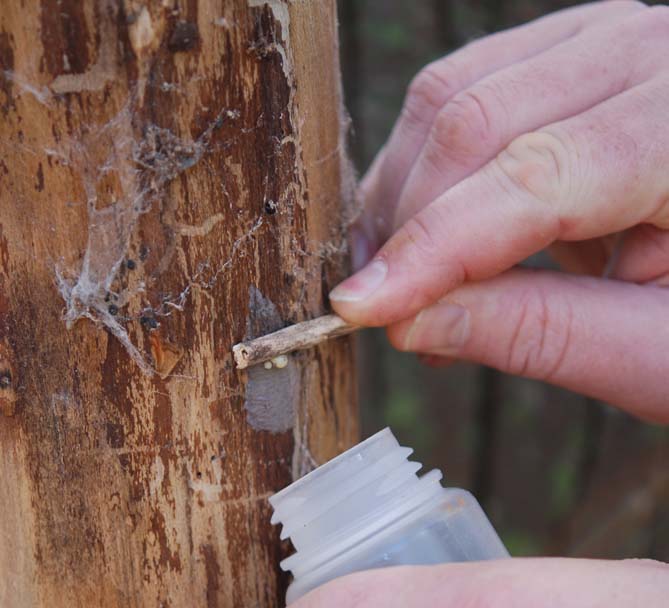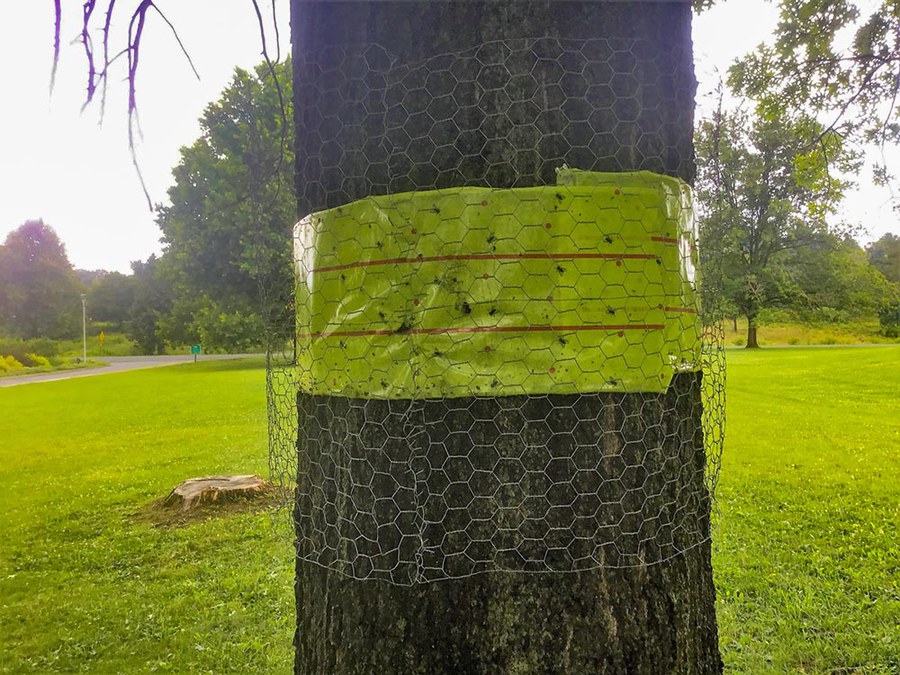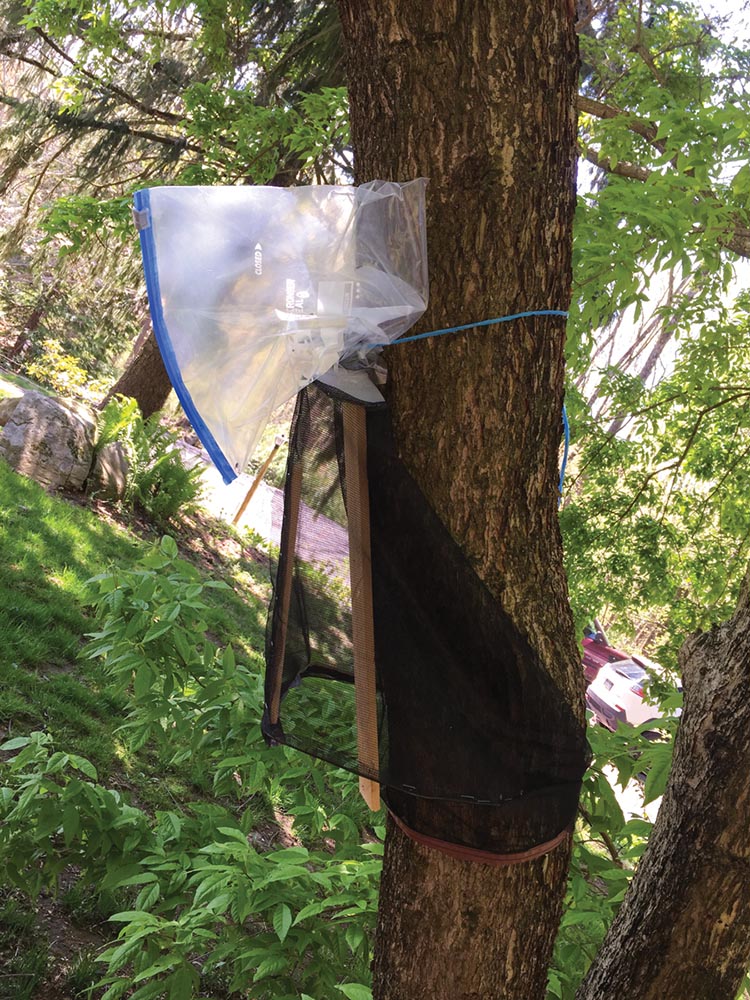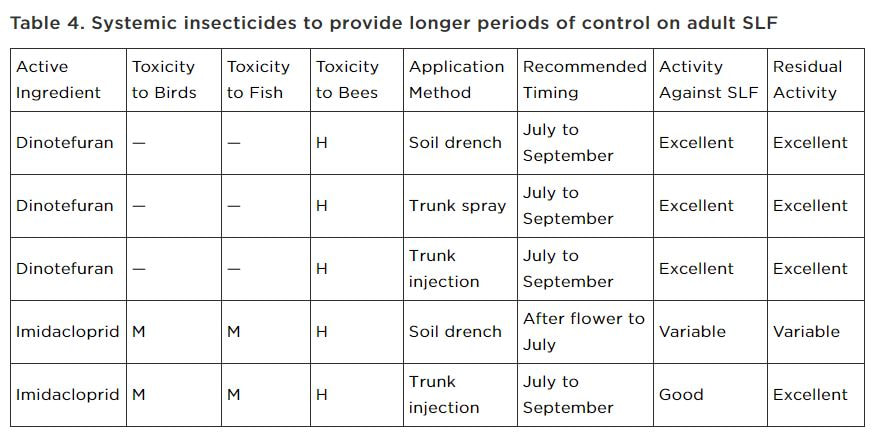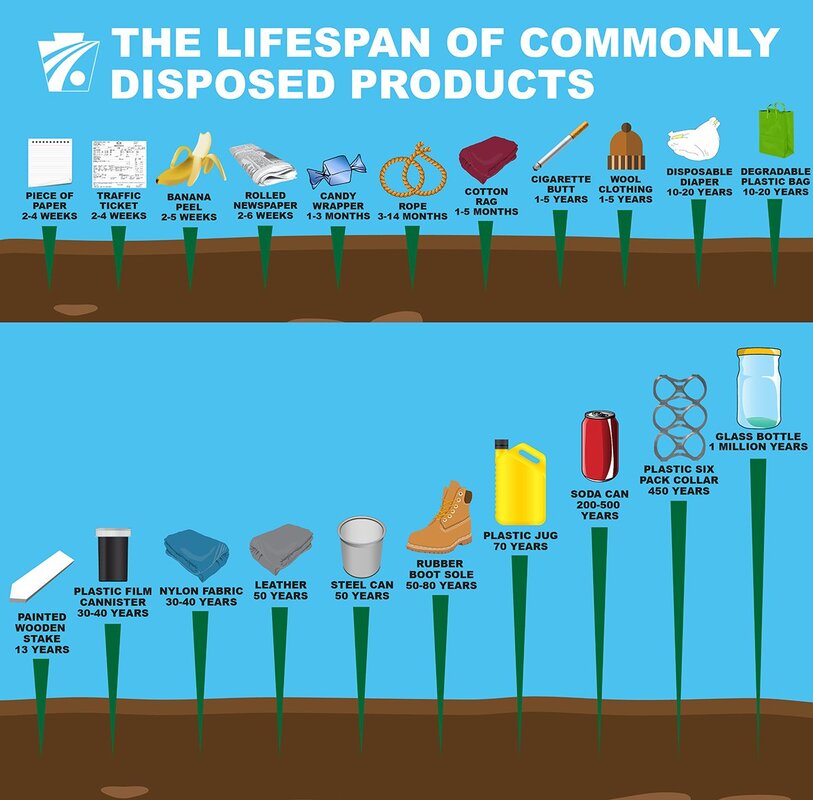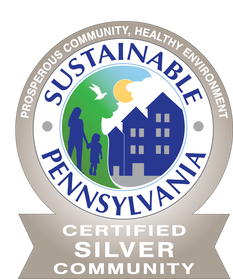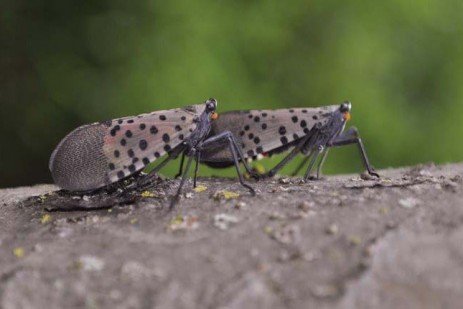 Adult spotted lanternflies. Photo Credit: E. Smyers
Adult spotted lanternflies. Photo Credit: E. Smyers https://extension.psu.edu/spotted-lanternfly-management-for-homeowners
A guide that reviews the identification, life cycle, current distribution, and techniques for managing spotted lanternfly on your property. Download PDF Available in Spanish
ARTICLES UPDATED: MAY 8, 2020
Introduction
Spotted lanternfly (SLF), Lycorma delicatula, is an invasive planthopper, native to Asia, that was first detected in southeastern Pennsylvania in 2014. It feeds on many plants, including economically important crops like grapevines and ornamentals. If you think you have SLF, do not panic! First, make sure the insect you are seeing is the spotted lanternfly. Second, learn about its life cycle and habits. Third, determine what plants it is infesting and what it is not. Fourth, employ effective management strategies at the proper time of the year.
Identification and Life Cycle
There is one generation of SLF per year. The eggs are laid in the fall and hatch in the spring. Egg masses are laid on hard surfaces (trees, decks, houses, outdoor equipment, rocks, etc.) and protected with a mud-like covering. Each egg mass contains 30–50 eggs. After hatching and before reaching adulthood, SLF goes through four nymphal stages. Nymphs are small (⅛ to ½ inch) and can be hard to find. The first three stages (instars) are all black with white spots, and the last instar is red with white dots and black stripes (Figure 1). SLF adults emerge in July and are active until winter. This is the most obvious and easily detectable stage because they are large (~1 inch) and highly mobile. Adults have black bodies with brightly colored wings. Only the adults can fly. SLF wings remain closed while they are feeding and walking. SLF wings are gray with black spots, and the tips of the wings are black with gray veins.
Figure 1. The life stages of SLF, including an egg mass on a tree.
- SLF is a destructive invasive pest threatening agricultural and ornamental plants.
- As of May 2020, 26 counties in Pennsylvania are under quarantine for SLF. SLF has also been found in 5 other states in the northeastern U.S.
- SLF does not bite or sting.
- SLF does not kill all trees it feeds on. SLF is a plant stressor that, along with other stressors, can cause significant damage to its host.
- Stop the spread of SLF by checking your car and any outdoor equipment (grills, mowers, firewood, etc.) when going in and out of the quarantine zone.
- Manage SLF on your property by scraping and destroying eggs, carefully using bands or traps on trees, removing preferred hosts, and using registered insecticides for control when appropriate.
An SLF quarantine is currently in effect for 26 counties in Pennsylvania (Figure 2). More counties may be added to the quarantine if additional populations of SLF are confirmed. If you find a spotted lanternfly, kill it and report it immediately with the Pennsylvania Department of Agriculture's online reporting system or by calling 1-888-4BAD-FLY (1-888-422-3359).
SLF is capable of causing serious damage to host plants, including oozing sap from the trees, wilting, leaf curling, and tree dieback. SLF feeds using a piercing-sucking mouthpart tapped into the plant like a straw. When SLF feeds, it excretes honeydew, a sugar-rich liquid waste product. Honeydew serves as a substrate for sooty mold, fungi that thrive in sugary environments. SLF expels significant amounts of honeydew, and often the plant surface and the area around infested plants become coated with honeydew and sooty mold. This mold is generally harmless to people but can damage the plant. If you see sooty mold or sticky areas on a plant or tree, it may be infested by SLF, but it could also be infested with other insects that produce honeydew, such as aphids, leafhoppers, or scales. Therefore, it is important to identify the cause of the mold, as control measures may differ for pests other than SLF.
There is no way to prevent SLF from moving onto your property. Be aware that SLF is very mobile and management actions must be continuous to keep them controlled.
Consequences of direct feeding damage to the host trees have not been quantified. SLF does not kill every tree on which it feeds. Some plants are at more risk than others. Plant death has only been observed in grapevines, tree-of-heaven, and some tree saplings. SLF is a plant stressor that, in combination with other stressors (e.g., diseases, weather), can cause significant damage to host plants. Following high infestation levels, flagging and canopy dieback of black walnut, willow, staghorn sumac, and maple have been reported. It is possible that after heavy feeding, multiple years of sustained damage, or particularly dry years, SLF may cause significant damage to ornamental and shade trees. However, currently SLF is predominantly considered a nuisance pest for homeowners, and death has not been reported in any ornamental tree.
Seasonal Host Phenology
SLF has a broad host range and has been recorded feeding on over 65 different plant species. Despite this broad host range, some plants appear to be more favorable to SLF than others. Numerous variables appear to determine the attractiveness of a particular plant, including what other plants species are available in the nearby landscape, the health of the plant, the time of year, the SLF population size, and how long SLF has been present in the area. We emphasize that not every tree needs to be treated. Scout the area first, and then consider treating if high populations are found. Nymphs, in particular, seem to have an especially large host range, whereas adults seem to depend more on certain hosts. Table 1 lists the key plant hosts of SLF and the time at which SLF are most likely to be found on these hosts. This table does not represent a comprehensive list of the plants on which SLF feeds; rather, it shows the patterns of SLF feeding that have been observed through the season. Plants are less likely to serve as hosts for SLF as they begin to senesce at the end of the growing season. The patterns in host use may change with varying weather conditions, region, and other undetermined factors.
Table 1. Key plant hosts of SLF throughout the growing season:
Table 2. Select management options appropriate for the time of year
When you travel in and out of the quarantine zone, check your car and any outdoor items you are moving (grills, outdoor furniture, landscaping supplies, mowers, etc.). Check for SLF egg masses from September through June. Remember that egg masses may be underneath your car or in your wheel wells. During all other times of the year, check for nymphs and adults, and keep your windows rolled up when you park. Don't store things or park under infested trees, and don't move firewood.
Steps of Spotted Lanternfly Management
- Stop the spread
- Scrape egg masses
- Use tree traps to catch nymphs
- Remove host plants
- Apply insecticides
Walk around your property to check for egg masses on trees, cement blocks, rocks, and any other hard surface. If you find egg masses on your property from September to May, you can scrape them off using a plastic card or putty knife (Figure 3). Scrape them into a bag or container filled with rubbing alcohol or hand sanitizer and keep them in this solution permanently. Egg masses can also be smashed. Remember that some eggs will be unreachable at the tops of trees, in other well-hidden areas, and throughout your neighborhood and community. Be aware that this method may not reduce the number of nymph or adult SLF you see later in the year.
After the eggs hatch, nymphs will walk up the trees to feed on the softer new growth of the plant. Nymphs frequently fall to the ground, walk to trees, and walk back up the trunks. Take advantage of this behavior by wrapping tree trunks in tree traps to catch the nymphs (Figure 4). Traps can be used on any tree, but we recommend only banding trees where SLF is abundant. You can use either sticky bands or a funnel-style trap. Sticky bands may be purchased online or from your local garden center. Push pins can be used to secure the band. While some bands may catch adults, banding trees is most effective for nymphs. Be advised that birds and small mammals stuck to the bands have been reported. To avoid this, you should cage your sticky bands in wire or fencing material wrapped around the tree. Alternately, try reducing the width of the band, so that less surface area is exposed to birds and other mammals. Both of these methods will still capture SLF effectively. To eliminate the risk of catching birds and mammals, you can use funnel-style traps that consist of mesh wrapped around the tree that leads into a container to trap SLF (Figure 5). Some companies may be producing these traps commercially, or you could also make your own. The mesh (e.g., plastic netting) should be wrapped around the entire circumference of the tree and funnel into a container (e.g., inverted peanut butter jar or plastic bag) with a hole in the lid to allow SLF nymphs and adults to pass through. Read more about trapping SLF in “ Using Traps for Spotted Lanternfly Management ". Check and change traps at least every other week (or more often in highly infested areas). Be aware that this method may not reduce the number of nymph or adult SLF you see later in the year.
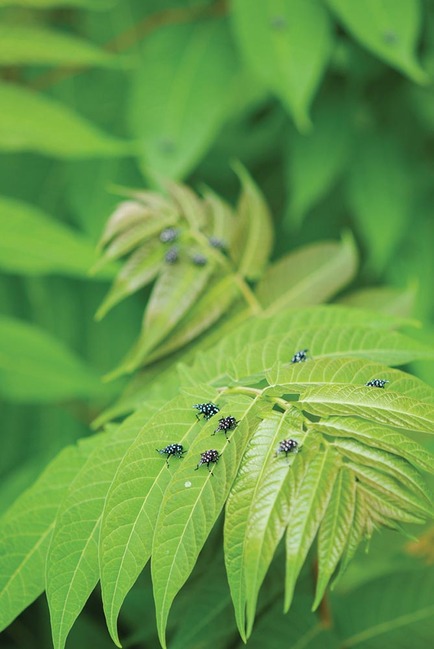 Figure 6. Early instar SLF feeding on the invasive plant tree-of-heaven.
Figure 6. Early instar SLF feeding on the invasive plant tree-of-heaven. Tree-of-heaven (Ailanthus altissima) is an invasive plant that is common in landscapes and disturbed areas, such as along the sides of roads (Figure 6). This is a preferred host tree for SLF, and current management efforts are focused on removing it or using it as a trap tree by treating it with insecticide. Tree-of-heaven grows rapidly; it can reach up to 100 feet tall and 6 feet in diameter. The bark of mature tree-of-heaven looks similar to the outside of a cantaloupe. When crushed, the leaves and stems have a foul odor that many describe as rotten peanut butter. They spread by seed and will also produce “clones" by their roots. This tree can be mistaken for other native species, including black walnut, hickory, and staghorn sumac. For help identifying and treating this plant, visit the Penn State Extension spotted lanternfly website.
Use recommended methods to apply herbicide to the tree from July to September and wait at least 30 days before removing the tree. Failure to apply herbicide will result in new growth from the stump and/or roots. Even when treated with herbicide, multiple applications may be necessary over time to completely kill the tree. These trees can get very tall, so seek the help of a tree care service if necessary.
Other undesirable invasive species, such as oriental bittersweet, can support populations of SLF and can also be removed. While tree-of-heaven is a preferred host, SLF feeds on a large variety of plants, including many of the ornamental trees commonly found in residential landscapes. Removing these may not be preferred and may not help reduce SLF on your property; refer to the next section for further guidance.
Only use insecticides that are registered by the Environmental Protection Agency (EPA) to treat any insect on your property. All EPA-registered insecticides have an EPA registration number and a label for safe, appropriate, and legal use. Home remedies should not be used against SLF because they may be unsafe to humans, pets, and plants and could be illegal.
Insecticides can kill insect pests on contact and/or by being present systemically in a plant on which they feed. The duration of control that remains after application (i.e., residual activity) varies depending on which type of insecticide is used. Contact insecticides kill SLF when the chemical contacts the insect as a direct spray. Some contact insecticides have long residual activity and can continue killing SLF when they walk over a surface covered with insecticide residue. Systemic insecticides are absorbed by tree roots, bark, or leaves and are moved through its vascular system to other parts of the tree. When systemic insecticides are used, SLF is killed as it feeds on any part of the tree, even if it was not sprayed directly (e.g., spraying the lower part of the tree will protect the treetops). Systemic insecticides work best when applied from July to September. However, systemics can also be applied at other times of year, depending on the application method and the product used. For example, a soil drench containing imidacloprid should be applied earlier in the summer.
There are four main methods to apply insecticides: tree injection (usually applied by professional applicators), bark sprays, soil drenches, and direct sprays (can be applied by homeowners). Systemic insecticides can work well and have residual activity that lasts from several weeks to several months. Property owners should consider hiring a certified pesticide applicator to make insecticide applications. Professional applicators have specialized training and equipment to treat trees.
Insecticides that are available to home gardeners can be used as soil drenches, bark sprays, or direct sprays. They must be used according to the directions on the product label. Direct sprays of contact insecticides are applied directly to SLF and surfaces where they feed and walk, which is often the base of a tree where spotted lanternflies are abundant. Systemic insecticides can be applied using any of the methods listed on the label, but keep in mind that systemics take time to move into the tree. Systemic insecticides should only be applied to actively growing trees, so they should not be applied in late fall or winter. You may apply systemic insecticides as a soil drench around the base of the tree, as a bark spray on the trunk of the tree, or as a direct spray on the leaves of the tree. Systemic insecticides can also be injected into a tree, but this requires special equipment by tree care professionals. Bark sprays have been shown to work well for SLF control, but some of these products also require being mixed with a penetrant, which allows the insecticide to penetrate the bark and move into the tree. You must read the label of the insecticide you purchase to determine whether it should be used as a soil drench, bark spray, or direct spray.
Soil drenches of systemic insecticides are applied into the soil around the trunk of the tree. The insecticide is taken up by the roots and moved into the rest of the tree. Ideally, soil drenches work best when applied in the early summer to trees that had high SLF populations in the past and are likely to have them again. To protect pollinators, soil drenches of systemic insecticides should be applied after a tree's flowers have faded. Soil drenches and bark sprays of systemic insecticides may take several days or weeks to move within the entire tree; so, unlike contact sprays, you should not expect immediate results. Depending on the product and rates used, soil drenches, bark sprays, and injections have the advantage of longer residual activity (several weeks to several months) over contact insecticide applications.
In Tables 3 and 4, the name of the product is listed, along with the mode of exposure, legal use, activity ranking against SLF, and residual activity (how long it stays active). Specific products listed are not an endorsement. Note that most available insecticides registered for use in Pennsylvania will not have SLF listed as a target pest on the label. If the intent is to treat ornamental plants infested with SLF on the property, select insecticides specifically labeled for use on ornamental trees and shrubs. Pennsylvania law allows the application of an insecticide for control of a pest not listed as long as the site is included on the label. Research is ongoing to identify the insecticides that are most effective on SLF while posing the least risk to humans, pets, beneficial insects, and the environment. Additional field trials are being conducted to test the efficacy and residual activity of a wider range of the insecticides that are available to homeowners. We have not yet evaluated nontarget effects of listed insecticides on beneficial insects, including pollinators. We do not recommend treating your entire property since these insecticides are not specific to SLF and beneficial insects may be affected as well. Only treat areas where SLF is abundant.
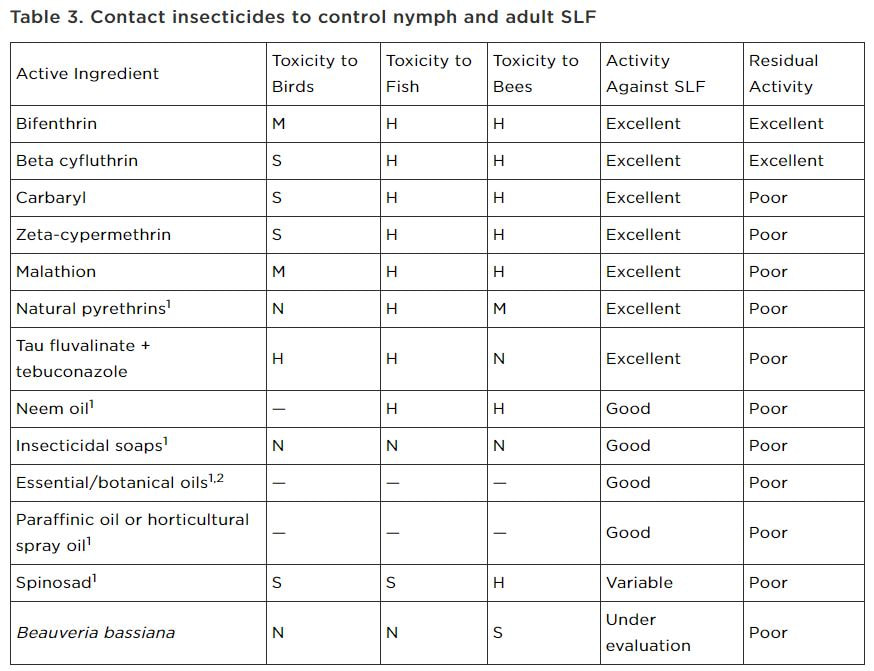
Water Contamination
Every precaution should be taken to protect surface water and groundwater from pesticide contamination. Trunk injections pose the smallest risk to contaminating water because the insecticide goes directly into the tree. Soil drench applications should only occur directly adjacent to the trunk of the tree, as directed on the label. Soil drenches should not be applied to sandy soils or where the water table is shallow. Both dinotefuran and imidacloprid can persist in groundwater for extended periods. When exposed to sun, both of these compounds break down readily. To protect surface water, systemic insecticides should not be applied near open water sources (ponds, lakes, streams).
Pollinators and Other Insects
Many of the trees on which SLF have been observed feeding in high densities are also pollinated by bees (e.g., maples and oaks). It is possible that trees treated with systemic insecticides could have insecticide residue in the flowers and nectar the following spring. Neonicotinoid insecticides, in particular, have been associated with bee health decline. Additionally, there are many native insects that utilize these trees at the same time as SLF (e.g., caterpillars, beetles, lady beetles, lace-wings, parasitoid wasps) and could be affected by the treatment. Pyrethroids can also be damaging to beneficial insect populations and could cause populations of secondary pests, such as mites and scale, to increase. Generally, systemic insecticides are considered to have a reduced impact on beneficial insects compared to broad-spectrum foliar-applied insecticides. We are currently conducting research to determine the effect of SLF treatments on pollinators and other nontargets.
These recommendations are current as of May 2020 and may change as we learn more. We encourage you to stay up to date by visiting the Penn State Extension Spotted Lanternfly page. Check for the newest version of this fact sheet and always look for the most up-to-date information. When using any pesticide, follow the pesticide label for directions, application rates, methods, and appropriate protective equipment.
Revised by Heather Leach, Emelie Swackhamer, Amy Korman, and Brian Walsh. Originally prepared by Heather Leach, David Biddinger, and Greg Krawczyk.
This fact sheet was produced by Penn State Extension in collaboration with the Pennsylvania Department of Agriculture and the United States Department of Agriculture

